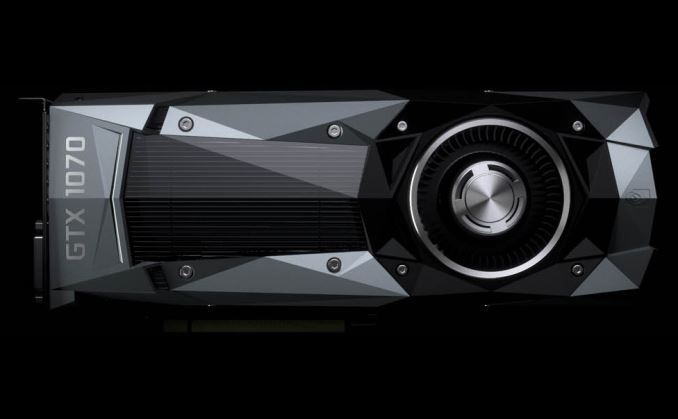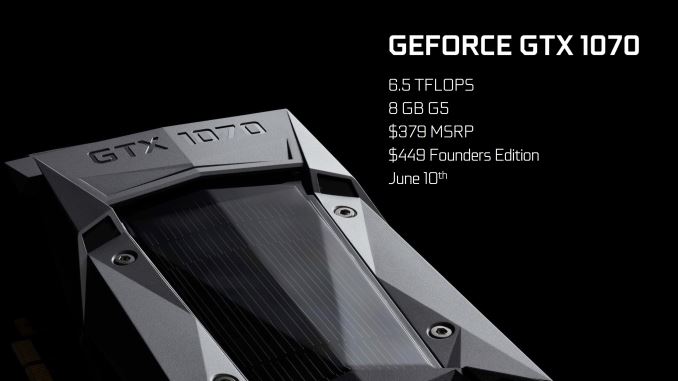NVIDIA Posts Full GeForce GTX 1070 Specifications: 1920 CUDA Cores Boosting to 1.68GHz
by Ryan Smith on May 18, 2016 10:15 PM EST
Back when NVIDIA first announced the GeForce GTX 1080 earlier this month, they also briefly announced that the GTX 1070 would be following it. The GTX 1070 would follow the GTX 1080 by two weeks, and presumably to keep attention focused on the GTX 1080 at first, NVIDIA did not initially reveal the full specifications for the card. Now with the GTX 1080 performance embargo behind them – though cards don’t go on sale for another week and a half – NVIDIA has posted the full GTX 1070 specifications over on GeForce.com.
| NVIDIA GPU Specification Comparison | ||||||
| GTX 1080 | GTX 1070 | GTX 970 | GTX 770 | |||
| CUDA Cores | 2560 | 1920 | 1664 | 1536 | ||
| Texture Units | 160 | 120 | 104 | 128 | ||
| ROPs | 64 | 64 | 56 | 32 | ||
| Core Clock | 1607MHz | 1506MHz | 1050MHz | 1046MHz | ||
| Boost Clock | 1733MHz | 1683MHz | 1178MHz | 1085MHz | ||
| TFLOPs (FMA) | 8.9 TFLOPs | 6.5 TFLOPs | 3.9 TFLOPs | 3.3 TFLOPs | ||
| Memory Clock | 10Gbps GDDR5X | 8Gbps GDDR5 | 7Gbps GDDR5 | 7Gbps GDDR5 | ||
| Memory Bus Width | 256-bit | 256-bit | 256-bit | 256-bit | ||
| VRAM | 8GB | 8GB | 4GB | 2GB | ||
| FP64 | 1/32 | 1/32 | 1/32 | 1/24 | ||
| TDP | 180W | 150W | 145W | 230W | ||
| GPU | GP104 | GP104 | GM204 | GK104 | ||
| Transistor Count | 7.2B | 7.2B | 5.2B | 3.5B | ||
| Manufacturing Process | TSMC 16nm | TSMC 16nm | TSMC 28nm | TSMC 28nm | ||
| Launch Date | 05/27/2016 | 06/10/2016 | 09/18/14 | 05/30/13 | ||
| Launch Price | MSRP: $599 Founders $699 |
MSRP: $379 Founders $449 |
$329 | $399 | ||
Previously disclosed at 6.5 TFLOPs of compute performance, we now know how NVIDIA is getting there. 15 of 20 SMs will be enabled on this part, representing 1920 CUDA cores. Clockspeeds are also slightly lower than GTX 1080, coming in at 1506MHz for the base clock and 1683MHz for the boost clock. Overall this puts GTX 1070’s rated shader/texture/geometry performance at 73% that of GTX 1080’s, and is a bit wider of a gap than it was for the comparable GTX 900 series cards.
However on the memory and ROP side of matters, the two cards will be much closer. The GTX 1070 is not shipping with any ROPs or memory controller channels disabled – GTX 970 style or otherwise – and as a result it retains GP104’s full 64 ROP backend. Overall memory bandwidth is 20% lower, however, as the GDDR5X of GTX 1080 has been replaced with standard GDDR5. Interestingly though, NVIDIA is using 8Gbps GDDR5 here, a first for any video card. This does keep the gap lower than it otherwise would have been had they used more common memory speeds (e.g. 7Gbps) so it will be interesting to see how well 8Gbps GDDR5 can keep up with the cut-down GTX 1070. 64 ROPs may find it hard to be fed, but there will also be less pressure being put on the memory subsystem by the SMs.
Meanwhile as is usually the case for x70 cards, GTX 1070 will have a lower power draw than its fully enabled sibling, with a shipping TDP of 150W. Notably, the difference between the GTX 1080 and GTX 1070 is larger than it was for the 900 series – where it was 20W – so we’re going to have to see if GTX 1070 ends up being TDP limited more often than GTX 1080 is. In that sense TDP is somewhat arbitrary – its purpose is to set a maximum power consumption for cooling and power delivery purposes – and I’m not surprised that NVIDIA wants to stay at 150W or less for the x70 series after the success that was the GTX 970.
Like the GTX 1080, the GTX 1070 will be launching in two configurations. The base configuration is starts at $379 and will feature (semi) custom partner designs. Meanwhile as previously disclosed, NVIDIA will be offering a Founders Edition version of this card as well. The Founders Edition card will be priced at $449 – a $70 premium – and will be available on day one, whereas this is not guaranteed to be the case for custom cards.
The GTX 1070 Founders Edition card will retain the basic stylings of the GTX 1080, including NVIDIA’s new angular shroud. However I have received confirmation that as this is a lower TDP card, it will not get the GTX 1080’s vapor chamber cooler. Instead it will use an integrated heatpipe cooler similar to what the reference GTX 980 used.











137 Comments
View All Comments
Spunjji - Thursday, May 19, 2016 - link
Looks a lot like that what with the retrograde step in performance gain per dollar over the previous gen release and this "founders" nonsense.It definitely looks like they felt they gave away too good of a deal with the 970 given how they've widened the x70 to x80 performance gap, too. Shame.
blzd - Thursday, May 19, 2016 - link
I hope not. GTX 970 was the first time I even considered paying $400 (CDN) for a graphics card where as normally I'd pay $200 every 2 years or so.Basically they convinced folk like me to spend twice as much per upgrade cycle with the 970 level of performance.
just4U - Thursday, May 19, 2016 - link
I felt the same way about the Radeon 390 8G.. Been awhile since I've spent $400+ on a video card.. usually try to keep it to the high 200s or very low 300s.Jon Tseng - Thursday, May 19, 2016 - link
I'd disagree with your contention that CPU configuration is "directly related" to yields. Sometimes it is, sometimes it isn't; it can also be a commercial decision.Remember the config of the 1070 doesn't just affect sales of that SKU is also has knock-on implications for market share vs. AMD an also for unit sales of 1060 (when it arrives) and 1080.
You need to factor the margin profiles of these into the equation e.g. you might be cutting down the 1070 more than the yields require, but the gap in performance could drive more sales to the 1080 so you do better in absolute gross profit dollars.
It's more of an art than a science - it's not as simple as "we'll whack the configuration to the highest that yields allow us to do".
Also bear in mind that unlike previous leading edge nodes 16FF has been battle-tested by Apple A9 which must be one of the highest volume high end processors in history, even assuming the Samsung 14nm split. Now I know the 16FF process for NVDA won't be the same as the low-power process, and the die size is significantly bigger, but that massive volume run would definitely be a tailwind for yields.
TristanSDX - Thursday, May 19, 2016 - link
GF 1070 do not have 7.2 B transistors. With dsabled 25% shaders, it have 5.4+ B. Shaders account for some 90% budget of transistors.casperes1996 - Thursday, May 19, 2016 - link
That's not how these tables work. Anandtech always shows the amount of transistors on the GPU, whether they are disabled or not. A GP 104 will show 7.2 billion no matter if it's cut down or not on AnandtechMrSpadge - Thursday, May 19, 2016 - link
It's not only about the tables, it's also about the physics and manufacturing. Each GP104 die contains 7.2 billion transistors, whether they're used or not.joex4444 - Thursday, May 19, 2016 - link
The transistors are present but not electrically active. If they reported 5.4B then they'd have the die size incorrect.mortenelkjaer - Thursday, May 19, 2016 - link
Volta it is.Eden-K121D - Thursday, May 19, 2016 - link
I'll wait for volta.....on a serious note lets see what polaris 10 has to offer